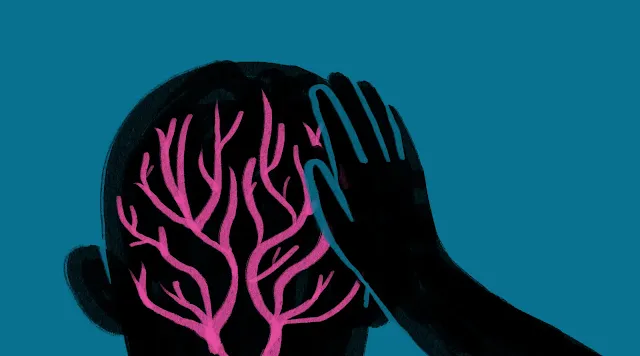Migraine - Types, Symptoms, Causes and more
A migraine is a neurological condition characterized by intense, debilitating headaches, often accompanied by other symptoms such as nausea, vomiting, and sensitivity to light and sound. Migraines can last for hours or even days and are more severe than typical headaches.
Types of Migraines
1. Migraine without Aura (Common Migraine)
- Description: The most common type, characterized by moderate to severe head pain without preceding sensory disturbances.
- Symptoms: Throbbing or pulsing pain, usually on one side of the head, sensitivity to light and sound, nausea, vomiting.
2. Migraine with Aura (Classic Migraine)
- Description: Involves visual or sensory disturbances before the onset of head pain.
- Aura Symptoms: Visual disturbances (flashing lights, blind spots), sensory changes (numbness, tingling), difficulty speaking.
- Headache Symptoms: Similar to migraine without aura.
3. Chronic Migraine
- Description: Migraines occurring 15 or more days per month for more than three months.
- Symptoms: Frequent migraines with or without aura, often overlapping with tension headaches.
4. Migraine with Brainstem Aura
- Description: A rare type of migraine that affects the brainstem.
- Symptoms: Vertigo, slurred speech, double vision, coordination problems, and often severe throbbing pain.
5. Hemiplegic Migraine
- Description: A rare and severe form that involves temporary paralysis or sensory changes on one side of the body.
- Symptoms: Weakness on one side of the body, similar to stroke symptoms, along with typical migraine pain.
6. Retinal Migraine
- Description: Causes temporary blindness or visual disturbances in one eye before the headache begins.
- Symptoms: Visual disturbances in one eye (flashing lights, blindness) followed by headache.
Causes of Migraines
The exact cause of migraines is not fully understood, but several factors are believed to contribute:
1. Genetic Factors: Migraines tend to run in families, indicating a genetic predisposition.
2. Environmental Triggers: Certain triggers can induce migraines, including stress, hormonal changes, certain foods, alcohol, caffeine, weather changes, and lack of sleep.
3. Neurological Factors: Migraines are linked to changes in brain chemicals, including serotonin, which helps regulate pain.
4. Vascular Changes: Fluctuations in blood flow to the brain can also play a role in triggering migraines.
Symptoms of Migraines
1. Prodrome Phase (Pre-Headache):
- Mood changes
- Food cravings
- Stiff neck
- Increased thirst and urination
- Frequent yawning
2. Aura (if present):
- Visual disturbances (flashing lights, zigzag patterns)
- Sensory disturbances (numbness, tingling)
- Difficulty speaking or finding words
3. Headache Phase:
- Intense, throbbing pain, usually on one side of the head
- Nausea and vomiting
- Sensitivity to light, sound, and sometimes smell
- Blurred vision
- Lightheadedness or fainting
4. Postdrome Phase (Post-Headache):
- Feeling drained or washed out
- Confusion
- Mood changes
Treatment of Migraines
1. Medications:
- Pain Relievers: Over-the-counter drugs like aspirin, ibuprofen, and acetaminophen can be effective for mild migraines.
- Triptans: Prescription medications that block pain pathways in the brain (e.g., sumatriptan, rizatriptan).
- Ergots: Medications that combine ergotamine and caffeine; useful for migraines lasting more than 48 hours.
- Anti-Nausea Drugs: Medications like metoclopramide or prochlorperazine to treat nausea associated with migraines.
- Preventive Medications: For frequent migraines, drugs like beta-blockers, antidepressants, anticonvulsants, and CGRP monoclonal antibodies may be prescribed.
2. Lifestyle and Home Remedies:
- Avoiding Triggers: Identifying and avoiding personal migraine triggers.
- Regular Sleep Schedule: Maintaining a regular sleep pattern.
- Hydration: Drinking plenty of water.
- Dietary Adjustments: Avoiding foods known to trigger migraines, such as aged cheese, processed meats, and alcohol.
- Stress Management: Techniques such as yoga, meditation, and biofeedback can help reduce stress-related migraines.
3. Alternative Therapies:
- Acupuncture: May reduce the frequency of migraines in some individuals.
- Biofeedback: A technique that teaches control over certain physiological functions, potentially reducing headache frequency and severity.
- Herbal Supplements: Butterbur and feverfew are sometimes used for migraine prevention, though their effectiveness and safety should be discussed with a healthcare provider.
When to Seek Medical Help
- Migraines are severely disabling or increase in frequency.
- You experience an aura for the first time.
- The pattern of your headaches changes.
- You develop new or unusual symptoms, such as weakness, double vision, or loss of consciousness.
Early diagnosis and treatment can help manage migraines effectively, reducing their impact on daily life.
Tags:
Disease

